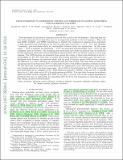Files in this item
From starburst to quiescence : testing AGN feedback in rapidly Quenching post-starburst galaxies
Item metadata
| dc.contributor.author | Yesuf, Hassen M. | |
| dc.contributor.author | Faber, S.M. | |
| dc.contributor.author | Trump, Jonathan R. | |
| dc.contributor.author | Koo, David C. | |
| dc.contributor.author | Fang, Jerome J. | |
| dc.contributor.author | Liu, F.S. | |
| dc.contributor.author | Wild, Vivienne | |
| dc.contributor.author | Hayward, Christopher C. | |
| dc.date.accessioned | 2014-09-23T10:01:05Z | |
| dc.date.available | 2014-09-23T10:01:05Z | |
| dc.date.issued | 2014-07-14 | |
| dc.identifier | 150540359 | |
| dc.identifier | 3ee403b3-5ace-4898-bbcb-08e2ec988830 | |
| dc.identifier | 84906751867 | |
| dc.identifier | 000341172200002 | |
| dc.identifier.citation | Yesuf , H M , Faber , S M , Trump , J R , Koo , D C , Fang , J J , Liu , F S , Wild , V & Hayward , C C 2014 , ' From starburst to quiescence : testing AGN feedback in rapidly Quenching post-starburst galaxies ' , Astrophysical Journal , vol. 792 , no. 2 , 84 . https://doi.org/10.1088/0004-637X/792/2/84 | en |
| dc.identifier.issn | 0004-637X | |
| dc.identifier.other | ArXiv: http://arxiv.org/abs/1407.3834v1 | |
| dc.identifier.other | BibCode: 2014ApJ...792...84Y | |
| dc.identifier.uri | https://hdl.handle.net/10023/5472 | |
| dc.description | We acknowledge financial support from the NSF grant AST-0808133. C.C.H. is grateful to the Klaus Tschira Foundation for financial support. | en |
| dc.description.abstract | Post-starbursts are galaxies in transition from the blue cloud to the red sequence. Although they are rare today, integrated over time they may be an important pathway to the red sequence. This work uses SDSS, GALEX, and WISE observations to identify the evolutionary sequence from starbursts to fully quenched post-starbursts in the narrow mass range log M(Msun) = 10.3-10.7, and identifies "transiting" post-starbursts which are intermediate between these two populations. In this mass range, ∼0.3% of galaxies are starbursts, ∼0.1% are quenched post-starbursts, and ∼0.5% are the transiting types in between. The transiting post-starbursts have stellar properties that are predicted for fast-quenching starbursts and morphological characteristics that are already typical of early-type galaxies. The AGN fraction, as estimated from optical line ratios, of these post-starbursts is about 3 times higher (∼>36 ± 8%) than that of normal star-forming galaxies of the same mass, but there is a significant delay between the starburst phase and the peak of nuclear optical AGN activity (median age difference of ∼> 200 ± 100$ Myr), in agreement with previous studies. The time delay is inferred by comparing the broad-band near NUV-to-optical photometry with stellar population synthesis models. We also find that starbursts and post-starbursts are significantly more dust-obscured than normal star-forming galaxies in the same mass range. About 20% of the starbursts and 15% of the transiting post-starbursts can be classified as the "Dust-Obscured Galaxies" (DOGs), while only 0.8% of normal galaxies are DOGs.The time delay between the starburst phase and AGN activity suggests that AGN do not play a primary role in the original quenching of starbursts but may be responsible for quenching later low-level star formation during the post-starburst phase. | |
| dc.format.extent | 22 | |
| dc.format.extent | 3200233 | |
| dc.language.iso | eng | |
| dc.relation.ispartof | Astrophysical Journal | en |
| dc.subject | Galaxies: active | en |
| dc.subject | Galaxies: evolution | en |
| dc.subject | Galaxies: formation | en |
| dc.subject | Galaxies: starburst | en |
| dc.subject | Galaxies: stellar content | en |
| dc.subject | Galaxies: structure | en |
| dc.subject | QB Astronomy | en |
| dc.subject | QC Physics | en |
| dc.subject.lcc | QB | en |
| dc.subject.lcc | QC | en |
| dc.title | From starburst to quiescence : testing AGN feedback in rapidly Quenching post-starburst galaxies | en |
| dc.type | Journal article | en |
| dc.contributor.institution | University of St Andrews. School of Physics and Astronomy | en |
| dc.identifier.doi | 10.1088/0004-637X/792/2/84 | |
| dc.description.status | Peer reviewed | en |
| dc.identifier.url | http://adsabs.harvard.edu/abs/2014ApJ...792...84Y | en |
This item appears in the following Collection(s)
Items in the St Andrews Research Repository are protected by copyright, with all rights reserved, unless otherwise indicated.

